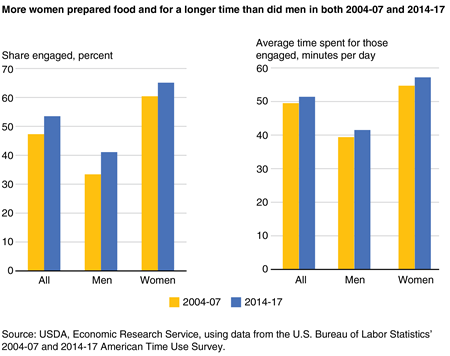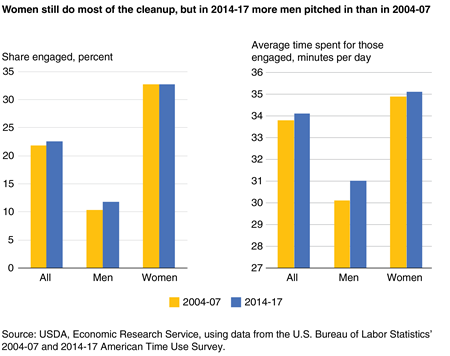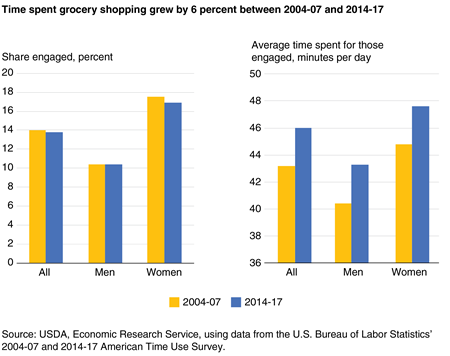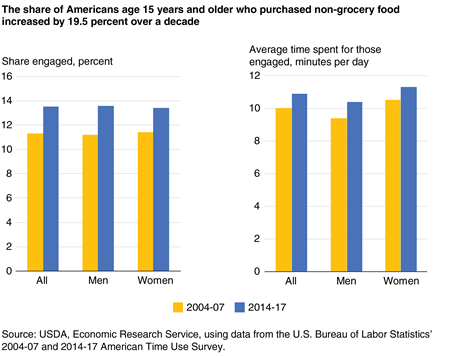More Americans Spend More Time in Food-Related Activities Than a Decade Ago
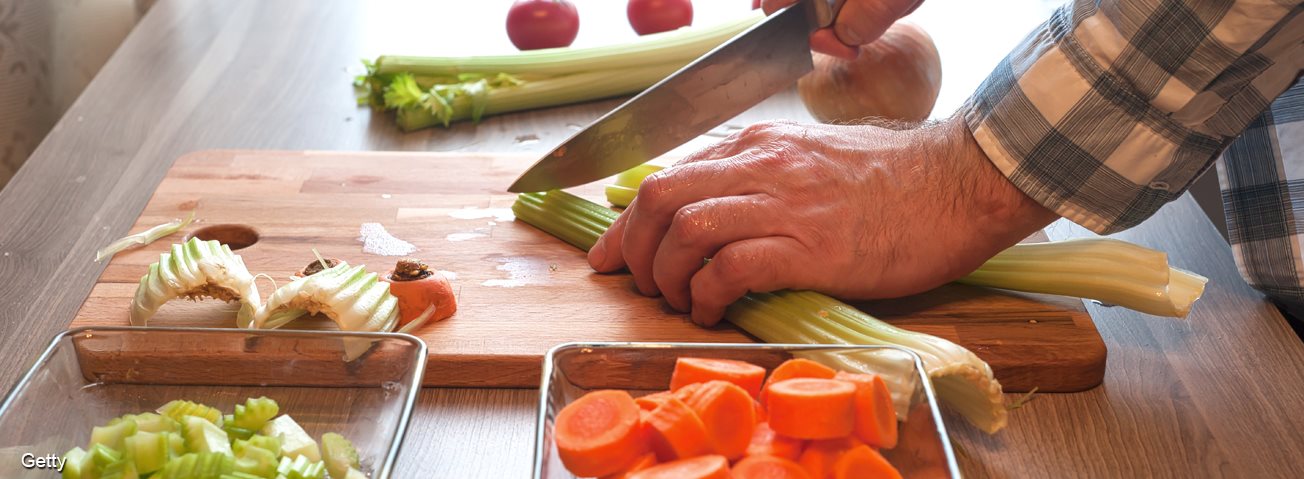
Analyzing how much time people devote to shopping for and preparing food can provide insights into behaviors that may affect their diets and, in turn, their health. For example, more time in the grocery store could indicate greater attention to product labels and healthier selections. When people prepare meals from scratch, they have greater control over the amount of salt, sugars, and fats used in the dishes. With home-prepared meals, people can align ingredients and cooking methods with their nutrition objectives.
ERS researchers used national statistics from the 2004-17 American Time Use Survey, conducted by the U.S. Bureau of Labor Statistics, to see if the time Americans spent in food-related activities varied between 2004-07 and 2014-17. The survey asked one individual age 15 and older in each surveyed household about his or her use of time over a 24-hour day, beginning at 4 a.m. on the day before the interview and ending at 4 a.m. on the interview day. The researchers found that on average, Americans spent 4.1 more minutes per day preparing food in 2014-17 than in 2004-07, and the gender disparity in food preparation lessened somewhat. These results and all other differences discussed in this article are statistically significant.
More Men Are Preparing Food, but the Majority of Meal Preparers Are Still Women
On an average day in 2014-17, 54 percent of Americans age 15 and older engaged in food preparation, up from 47 percent a decade earlier. Americans, on average, spent 27.5 minutes in food preparation in 2014-17, up from 23.4 minutes in 2004-07. These 4.1 extra minutes represent an 18-percent increase in the time devoted to preparing food. Among those who engaged in food preparation the day before the interview, the average time spent in the activity increased from 49.5 minutes in 2004-07 to 51.4 minutes in 2014-17. These time-use results echo previous ERS findings that, during the 2007-09 Great Recession, Americans reacted to the tough economic times by cutting back on eating out and choosing to prepare more food at home.
While a higher share of women prepared food in both time periods, the disparity lessened over the decade. In 2004-07, 60 percent of women and 33 percent of men engaged in food preparation on an average day. On an average day in 2014-17, 65 percent of women and 41 percent of men prepared food.
Women devoted more time to food preparation than did men in both time periods. In 2004-07, women who prepared food spent an average of 54.7 minutes per day in the activity compared with 39.4 minutes by men who prepared food. In 2014-17, time spent by food preparers averaged 57.2 minutes for women and 41.5 minutes for men.
Food Cleanup Still Done Mostly by Women
There were significant gender disparities in food-related cleanup in both survey periods. On an average day in 2014-17, 33 percent of women engaged in food-related cleanup, compared to 12 percent of men. A decade earlier, 33 percent of women and 10 percent of men took on cleanup duties.
Among those who engaged in food-related cleanup, women spent 34.9 minutes per day in the activity in 2004-07 and 35.1 minutes in 2014-17, compared with the 30.1 and 31.0 minutes spent by men in those years.
Time Spent Grocery Shopping Increased for Both Men and Women
From 2004-07 to 2014-17, the share of Americans who shopped for groceries on an average day stayed about the same at 14 percent. However, the average length of time Americans age 15 and older spent shopping for groceries on an average day grew by 6 percent, from 43.2 minutes in 2004-07 to 46.0 minutes in 2014-17. This longer time could reflect larger stores and longer aisles, larger selection of products to choose from, more interest in comparing prices or nutritional characteristics, or other factors.
On an average day in 2014-17, more women shopped for groceries than did men (17 percent versus 10 percent), and women grocery shoppers spent more time shopping than did men shoppers (47.6 versus 43.3 minutes).
More Women and Men Buy Non-Grocery Food Than a Decade Ago
Grocery stores are not the only place Americans get their food. The away-from-home market, which includes foods from full- and quick-service restaurants, schools, and other eating-out venues, accounted for an average of 34 percent of Americans’ calories in 2011-14.
From 2004-07 to 2014-17, the share of Americans who purchased non-grocery food (such as from a restaurant or school cafeteria) increased from 11.3 percent in 2004-07 to 13.5 percent in 2014-17. Counting only those Americans who purchased non-grocery food, 10.9 minutes per day were devoted to the activity, up 0.9 percentage points.
For these away-from-home foods, equal shares of men and women made the purchases—though women spent 9 percent more time on the activity than men did during the average day in 2014-17.
Food-Related Time Use: Changes and Demographic Differences, by Tobenna D. Anekwe and Eliana Zeballos , ERS, November 2019
Changes in Eating Patterns and Diet Quality Among Working-Age Adults, 2005-2010, by Jessica E. Todd, USDA, Economic Research Service, January 2014
America’s Eating Habits: Food Away From Home, by Michelle Saksena, Abigail Okrent, Tobenna D. Anekwe, Clare Cho, Chris Dicken, Anne Effland, Howard Elitzak, Joanne Guthrie, Karen Hamrick, Jeffrey Hyman, Young Jo, Biing-Hwan Lin, Lisa Mancino, Patrick W. McLaughlin, Ilya Rahkovsky, Katherine Ralston, Travis A. Smith, Hayden Stewart, Jessica E. Todd, and Charlotte Tuttle, ERS, September 2018


